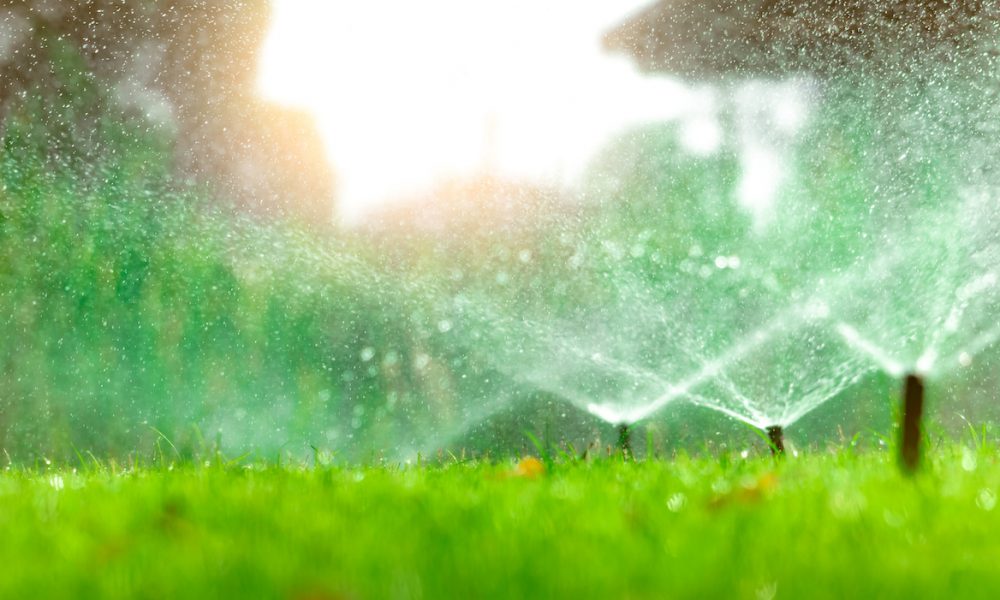
You’ve taken the time, money, and effort to seed your lawn with new grass. Now what? A proper watering schedule can easily turn your new lawn into the lush green grass you’ve always wanted. Watering new grass seed is a simple process that only requires a small investment of time.
Why Watering Matters To Your Lawn
During the first year of your lawn’s growth, whether it’s a newly seeded, sodded, sprigged, or plugged lawn, don’t rely solely on Mother Nature to do the watering. Additional irrigation should always be provided. When watering a newly seeded lawn, the key is to keep the top inch of soil consistently moist but not soggy.
Once the seeds start to germinate, continue to keep the top 2 inches of soil moist until the new grass reaches a mowing height of around 3 inches. After that, begin to cut back watering to twice per week and soak the soil deeper, about 6 to 8 inches, to encourage the grassroots to grow down deep into the soil.
Nature designed seeds to respond to moisture, so it makes perfect sense that watering grass seed properly is imperative to kick-start the germination process that results in healthy growth. Measuring the depth of water penetration is easy! Simply insert a long screwdriver into the ground. If it pushes down 6 to 8 inches without much resistance, you have the proper water saturation.
Remember that if the seeds are allowed to dry out, they will die. If you’re not receiving any rainfall, you’ll want to water new grass seed twice per day until the top couple inches of soil is moist. The best time to water grass seed is in the morning and evening.
Lawns that are a mixture of Kentucky bluegrass, perennial ryegrass, and fine fescues will go dormant during drought if not watered but will revive (re-green) when rain returns. Zoysia, St. Augustine, Bermuda, and centipede grasses develop deep root systems, making them better able to withstand drought. In general, warm-season grass types require less water than cool-season grasses.
Grass requires the most water in conditions of heat, drought, low humidity, and high winds. The type of soil you have also plays a part: Clay soil holds water longer and can be watered less frequently than sandy soil, which drains very quickly (and therefore needs to be watered more often).
Lawn Watering Solutions
Choose sprinklers that are low to the ground and use a horizontal spray pattern for best results. There are many different types of smart watering systems, and most systems integrate with in-ground sprinkler systems. Many have controllers that allow you to schedule watering using your smartphone and also use real-time weather data to automate watering so you don’t have to think about it.
Each has their own sets of benefits, so choose the solution that works best for you and your lawn. Below are a few methods to consider. These shoot water horizontally at a high velocity so the water isn’t affected by wind. Great for small- to medium-size lawns. There are many different types, so you can choose the one that fits your lawn best.
A water timer can simplify the process of when to water grass seeds, so you can easily and efficiently water your newly seeded lawn with no hassle at all. How to water new grass seed depends on the area you’ve seeded. Large areas can benefit from the use of a quality rectangular sprinkler.
How Long Should I Water My Lawn?
How long to water new grass seed depends on your soil conditions and your sprinkler setup. In general, ten minutes of watering per session (morning and evening) will provide enough water to keep the top couple inches of soil moist. As your new grass seed grows and flourishes, you can water deeper and less frequently – this will encourage established grassroots to extend deeply into the soil.
Eventually, you’ll want to water between 6 and 10 am, while the weather is still cool. An established lawn typically requires about 1 inch of water per week, including rainfall.
How Long Until I Have a Lush Beautiful Lawn?
How long it will take for your new grass seed to begin to grow really depends on where you live, your climate, and what type of grass you plant.
A beautiful, vibrant lawn not only looks great, but it also provides a place for you and your family to play, relax, and enjoy. A consistent water schedule for watering new grass seed is key to making sure you’re growing a healthy, lush green lawn that will give you years of enjoyment and beauty.
Professional Irrigation is a Great Way to Go
A professional irrigation system installation isn’t a luxury you’ll only see near mansions or upscale golf courses. In fact, they’re much more affordable than you’d imagine because they cut down on water waste generated by attempted to hand-water your property.
A home irrigation system is an excellent way to save time and money while reducing the amount of water waste. Not to mention, it’s convenient in that it takes care of watering so you don’t have to spend hours each week hand-watering your lawn. No more achy back and sunburn from standing out in the sun during a heatwave, and no more anxiety about whether or not your lawn received the proper amount of water.
Your new sprinklers will ensure your lawn, trees, shrubs, flowers, and vegetables are strong and vibrant all year round. Before we jump into the benefits of lawn irrigation systems, it’s valuable to know when your lawn is healthy versus when it’s sickly and in need of more (or less) water.
Contact Houseman Services today for a quote on a new irrigation system to keep your lawn lush and beautiful all year round!